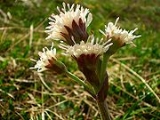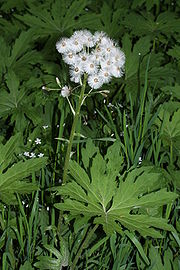
Petasites frigidus
Encyclopedia
Petasites frigidus is a species of Petasites
native to Arctic to cool temperate regions of the Northern Hemisphere
in northern Europe
, northern Asia
and northern North America
.
It is a herbaceous
perennial plant
producing flowering stems in early spring, and large leaves through the summer. The upright flower
ing stems are 10-20 cm tall, and bear only 5-12 inflorescence
s, yellowish-white to pink in colour. The leaves are rounded, 15-20 cm broad, with a deeply cleft base and shallowly lobed margin, and rise directly from the underground rootstock. The underside of the leaves is covered with matted, woolly, fuzz. It grows in moist shaded ground, preferring stream banks and seeping ground of cut-banks.
Petasites speciosa is treated as a distinct species by some authors, but Hitchcock & Cronquist (1955) synonymise it with P. frigidus.
 While there is some disagreement, some sources identify five varieties
While there is some disagreement, some sources identify five varieties
of P. frigidus:
dish. A salt-substitute can also be made by drying and then burning the leaves. This black, powdery substance will provide a salty taste.
Butterbur
The plants commonly referred to as Butterbur are found in the daisy family Asteraceae in the genus Petasites. They are mostly quite robust plants with thick, creeping underground rhizomes and large Rhubarb-like leaves during the growing season...
native to Arctic to cool temperate regions of the Northern Hemisphere
Northern Hemisphere
The Northern Hemisphere is the half of a planet that is north of its equator—the word hemisphere literally means “half sphere”. It is also that half of the celestial sphere north of the celestial equator...
in northern Europe
Europe
Europe is, by convention, one of the world's seven continents. Comprising the westernmost peninsula of Eurasia, Europe is generally 'divided' from Asia to its east by the watershed divides of the Ural and Caucasus Mountains, the Ural River, the Caspian and Black Seas, and the waterways connecting...
, northern Asia
Asia
Asia is the world's largest and most populous continent, located primarily in the eastern and northern hemispheres. It covers 8.7% of the Earth's total surface area and with approximately 3.879 billion people, it hosts 60% of the world's current human population...
and northern North America
North America
North America is a continent wholly within the Northern Hemisphere and almost wholly within the Western Hemisphere. It is also considered a northern subcontinent of the Americas...
.
It is a herbaceous
Herbaceous
A herbaceous plant is a plant that has leaves and stems that die down at the end of the growing season to the soil level. They have no persistent woody stem above ground...
perennial plant
Perennial plant
A perennial plant or simply perennial is a plant that lives for more than two years. The term is often used to differentiate a plant from shorter lived annuals and biennials. The term is sometimes misused by commercial gardeners or horticulturalists to describe only herbaceous perennials...
producing flowering stems in early spring, and large leaves through the summer. The upright flower
Flower
A flower, sometimes known as a bloom or blossom, is the reproductive structure found in flowering plants . The biological function of a flower is to effect reproduction, usually by providing a mechanism for the union of sperm with eggs...
ing stems are 10-20 cm tall, and bear only 5-12 inflorescence
Inflorescence
An inflorescence is a group or cluster of flowers arranged on a stem that is composed of a main branch or a complicated arrangement of branches. Strictly, it is the part of the shoot of seed plants where flowers are formed and which is accordingly modified...
s, yellowish-white to pink in colour. The leaves are rounded, 15-20 cm broad, with a deeply cleft base and shallowly lobed margin, and rise directly from the underground rootstock. The underside of the leaves is covered with matted, woolly, fuzz. It grows in moist shaded ground, preferring stream banks and seeping ground of cut-banks.
Petasites speciosa is treated as a distinct species by some authors, but Hitchcock & Cronquist (1955) synonymise it with P. frigidus.

Variety (biology)
In botanical nomenclature, variety is a taxonomic rank below that of species: as such, it gets a three-part infraspecific name....
of P. frigidus:
- P. frigidus var. frigidus
- P. frigidus var. nivalis, sometimes referred to as P. nivalis or P. hyperboreus. This variety is common at subalpine and alpineAlpine climateAlpine climate is the average weather for a region above the tree line. This climate is also referred to as mountain climate or highland climate....
elevations. - P. frigidus var. palmatus, sometimes referred to as P. palmatus, Palmate Coltsfoot, or Western Coltsfoot.
- P. frigidus var. sagittatus, arrowleaf sweet coltsfoot.
- P. frigidus var. vitifolius
Uses
The leaf stalks and flower stems (with flowers) are edible, and can be used as a vegetableVegetable
The noun vegetable usually means an edible plant or part of a plant other than a sweet fruit or seed. This typically means the leaf, stem, or root of a plant....
dish. A salt-substitute can also be made by drying and then burning the leaves. This black, powdery substance will provide a salty taste.

